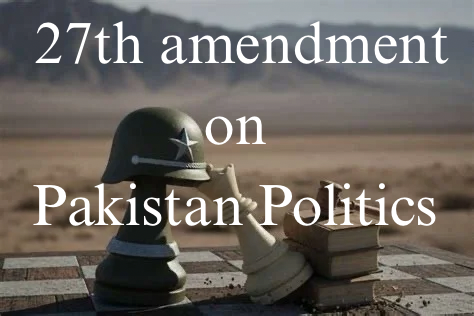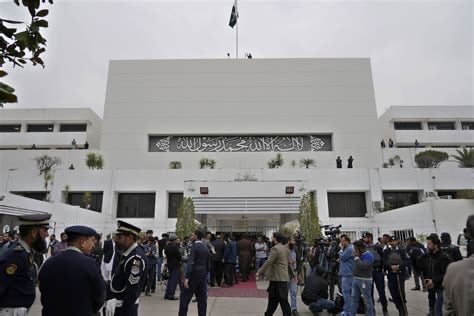Pakistan’s 27th Constitutional Amendment: Consolidating Power or Forging Stability?
Post Analysis of 27 Amendment on Pakistani Economy and Politics
POLITICS
Muhammad Umar Shabbir
11/18/20254 min read


A Nation Divided Over Foundational Changes
The amendment's key provisions have ignited a firestorm of debate
· A Unified Military Command: The creation of a Chief of Defence Forces (CDF)—a role conferred upon the current Army Chief, Field Marshal Asim Munir—consolidates command of the Army, Navy, and Air Force. The existing post of Chairman Joint Chiefs of Staff Committee is abolished. The amendment also constitutionally enshrines five-star ranks as lifelong titles.
· Sweeping Immunities: The amendment grants lifelong immunity from criminal prosecution to both the Field Marshal/CDF and the President, a protection that persists after they leave office.
· A Judicial Upheaval: The establishment of a new Federal Constitutional Court (FCC) strips the Supreme Court of its original jurisdiction over constitutional matters. The FCC's judges will be appointed through a process with significant executive input, while the Supreme Court's own constitutional benches are restructured.
Passed by a two-thirds majority from the ruling PML-N and PPP coalition amid opposition walkouts, the amendment is now the law of the land. But the battle over its legitimacy has just begun.
The Government’s Case: Security, Efficiency, and Stability
The government frames the 27th Amendment as a long-overdue modernization of the state's architecture. Its arguments are grounded in pragmatism and national interest:
· Unified Security Response: Proponents argue that a single, unified military command under a CDF is essential to counter modern threats, from cross-border tensions to internal terrorism. Defence Minister Khawaja Asif has stated this provides "constitutional clarity" for a command structure that recognizes the Army's central role and plugs critical gaps in the national security apparatus.
· Judicial Efficiency: The government presents the Federal Constitutional Court as a specialist body designed to clear the backlog of constitutional cases and expedite critical rulings. Law Minister Azam Nazeer Tarar describes it as an "evolutionary process" that fulfills long-discussed reforms.
· Institutional Stability: The immunity clauses are defended as a shield for high offices against politically motivated litigation, thereby preventing destabilizing prosecutions that could paralyze the state.
In this view, the amendment is a bold, necessary step to create a more cohesive, secure, and efficiently governed Pakistan.
Pakistan stands at a constitutional precipice. The enactment of the 27th Amendment on November 13, 2025, marks one of the most significant overhauls of the country's foundational document in decades. Signed into law by President Asif Ali Zardari after swift parliamentary passage, the amendment fundamentally reshapes the military command and the judiciary. The ruling coalition champions it as a necessary step for national security and efficiency, while the opposition declear it as a mortal blow to democracy and judicial independence, raising profound questions about its compatibility with Islamic principles of accountability.




The Opposition’s Rebuttal: A Constitutional Coup
For the opposition, led by PTI and legal alliances, the amendment represents a constitutional surrender. Their condemnation is absolute:
· The End of Judicial Independence: Redirecting constitutional matters to a new court, whose judges are appointed with executive influence, is seen as a blatant attempt to neuter the judiciary. The resignation of two Supreme Court judges in protest underscores this fear, with critics warning of a "captured court" that will no longer act as a check on executive power.
· The Militarization of the State: Elevating the Army Chief to a constitutionally protected, lifelong position with immunity formalizes military supremacy over civilian institutions, effectively reversing the fragile journey toward civilian supremacy.
· A Conflict with Islamic and Democratic Principles: The grant of lifelong immunity has drawn fierce religious and ethical criticism. Opponents argue it creates a class of untouchables above the law, directly contradicting the Quranic injunction to "stand out firmly for justice" (Surah An-Nisa) and the Islamic tenet that no individual, regardless of status, is immune from accountability.
Human rights organizations and international observers have echoed these concerns, warning of an accelerated slide toward authoritarianism.
The Core Dilemma: Is a New Constitutional Court the Solution?
The creation of the FCC is the amendment's most contentious legal innovation. While the government cites specialization and efficiency, skeptics see a more political motive. Pakistan's Supreme Court already possesses the machinery to handle constitutional cases through specialized benches. Critics argue that establishing a parallel court fragments the judiciary, invites forum-shopping, and, most critically, allows the executive to bypass a historically independent—and occasionally recalcitrant—Supreme Court. The question remains: was this reform about efficiency, or about control?
A Watershed Moment for Pakistan
The 1973 Constitution has been amended 26 times before, often reflecting the temporary dominance of one political or military force over another. The 27th Amendment, however, may represent a more permanent re-ordering of the state's power dynamics.
It promises streamlined security and governance in a nation beset by challenges. Yet, it achieves this by concentrating authority and insulating the powerful from accountability. As opposition parties vow to challenge it in the remaining courts and on the streets, the Pakistani people are left to ponder a fundamental question: in the quest for stability, has the nation traded away the very democratic and ethical foundations upon which its future progress depends? The long-term consequences will be determined by whether this amendment fosters genuine unity or becomes the source of deeper, more intractable division.


